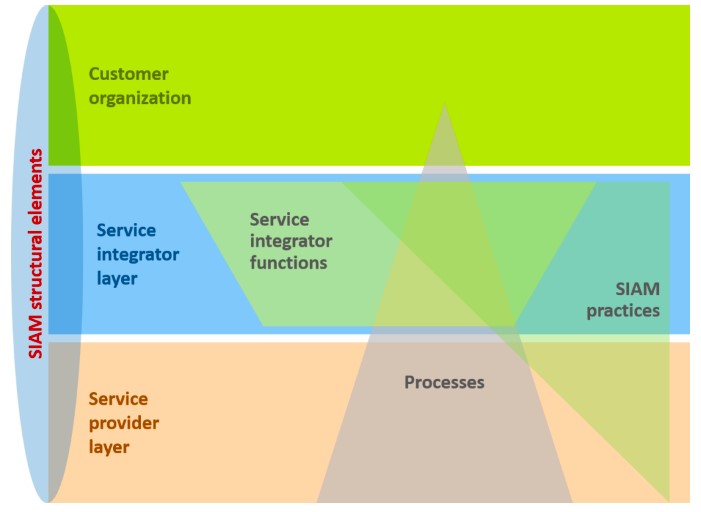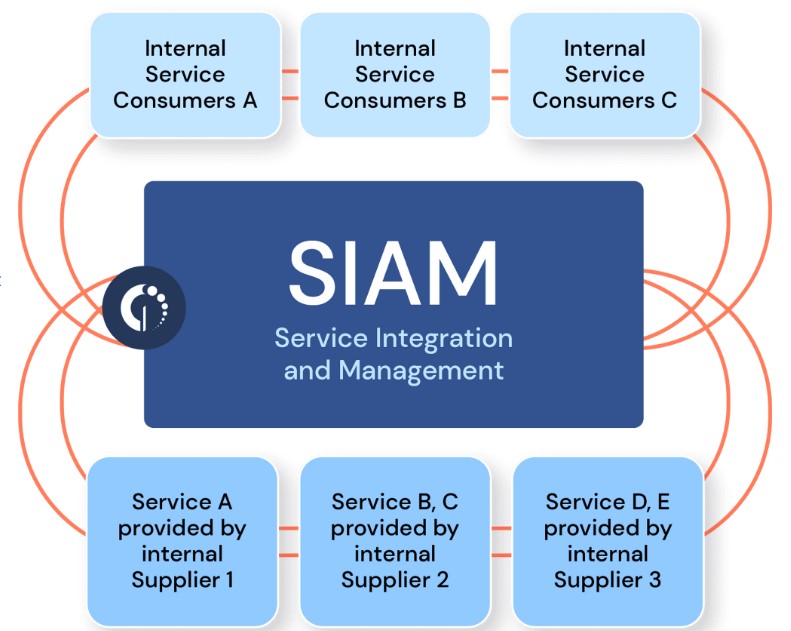Table of Contents
ToggleAs management practices are evolving faster in the digital age, enterprises are heavily reliant on Information Technology (IT) to support their day-to-day operations and drive exponential growth. However, managing the complex web of IT systems and services has become increasingly challenging when there is a digital transformation happening along with the introduction of other frameworks and methodologies within. This is where Service Integration and Management (SIAM) comes into play.

What is SIAM?
SIAM is a management methodology that enables seamless and effective coordination of multiple service providers to deliver high-quality IT services to organizations. It provides a structured framework for integrating and managing service providers, ensuring that they work together cohesively to meet the organization’s objectives. SIAM helps organizations overcome the challenges associated with multiple service providers by introducing consistent processes, clear governance, and improved communication channels.

Source: Scopism
The Need for SIAM
The IT industry is witnessing a significant shift towards multi-sourcing, with organizations increasingly relying on a combination of in-house teams, external vendors, and cloud service providers to meet their IT needs. While this approach offers benefits such as cost savings and introduces one to specialized skills, it also helps manage complexities in relationships, ensuring service quality, and thus achieving synergy among different providers. According to Spherical Insights, the global IT services market size is expected to reach USD 2554.76 Billion by 2030, growing at a CAGR of 5.8% during 2021-2030.
Organizations face several challenges in effectively managing multiple service providers. These include:
1. Lack of coordination: Different service providers often have their processes, tools, and ways of working, making it difficult to align their efforts towards a common goal.
2. Communication gaps: Communication breakdowns between service providers can lead to delays, misunderstandings, and even service disruptions, adversely impacting business operations.
3. Complex governance: Managing contracts, SLAs (Service Level Agreements), and compliance requirements across multiple service providers becomes increasingly complex and time-consuming.
4. Low visibility and accountability: With a centralized view of all services and providers, organizations may be able to track performance, identify issues, and hold service providers accountable for their actions.
The SIAM Framework
The SIAM framework provides a structured approach to address these challenges and maximize the value delivered by service providers. It consists of several key components:
1. Service Integration: The heart of SIAM lies in the service integrator role, which acts as the central point of coordination and control for all service providers. The service integrator ensures that services are integrated and delivered cohesively, manages relationships with service providers, and governs the end-to-end service delivery.
2. Governance: Effective governance is crucial for successful SIAM implementation. It entails defining roles, responsibilities, and decision-making mechanisms, establishing clear SLAs and performance measures, and monitoring service provider performance to ensure compliance with contractual obligations.
3. Processes and Tools: SIAM introduces standardized processes and tools to streamline service integration and management. This includes processes for service definition, onboarding, change management, incident management, and continuous improvement, among others. Tools such as service catalogs, dashboards, and workflow management systems help automate and streamline these processes.
4. Collaboration and Communication: SIAM emphasizes the need for effective collaboration and communication among service providers. Clear channels of communication, regular meetings, and shared platforms help foster collaboration, knowledge sharing, and issue resolution among service providers.

Source: InvGate
SIAM – A Game Changer for Organizations Globally
Below are some of the highlighted points that help organizations realize why SIAM is a game changer for organizations across industry sectors globally.
1. Improved Service Quality: By ensuring seamless coordination among service providers, SIAM enhances service quality, reducing incidents and improving customer satisfaction. Organizations, in turn, can better meet SLAs and achieve business objectives.
2. Cost Optimization: SIAM helps organizations leverage the strengths of different service providers, reducing duplication and inefficiencies. It enables effective resource utilization, optimized service delivery models, and better cost control, driving higher cost savings.
3. Enhanced Flexibility and Agility: SIAM enables businesses to quickly adapt to changing needs by effectively onboarding new service providers or scaling existing services. This flexibility or agility helps organizations to stay competitive in an evolving market.
4. Increased Visibility and Control: With a centralized view of all services and providers, organizations have greater visibility into service performance and provider compliance. This improves decision-making, problem identification, and issue resolution at a faster pace.
5. Comprehensive Governance: SIAM introduces a robust governance framework, providing organizations with the necessary oversight and control over service providers. This ensures compliance with SLAs, facilitates effective risk management, and helps organizations achieve their strategic objectives.

SIAM Implementation Challenges
Any new implementation of sorts will have its fair share of challenges, and SIAM is no different. Some of the key challenges to implement SIAM include:
1. Organizational Alignment: SIAM requires changes in organizational structures, roles, and processes. Organizational resistance to change and lack of alignment across different departments can impede implementation efforts.
2. Service Provider Collaboration: Convincing service providers to adopt and align with SIAM processes and collaborate effectively can be challenging. Some providers may resist change or need help to better adapt their ways of working to fit within the SIAM framework.
3. Skill and Knowledge Gap: Implementing SIAM requires a unique set of skills and knowledge. Organizations may need help finding or developing resources with the required expertise in SIAM practices. The best way to go about this is to train the relevant workforce in SIAM Foundation training, which introduces the concepts of the SIAM framework. In contrast, SIAM Professional training delves into implementing SIAM practices in an organization.
Conclusion
SIAM is proving to be an essential methodology for managing the complexities of IT service delivery in multi-provider environments. It provides organizations with a structured framework to integrate and manage service providers, ensuring effective coordination, improved service quality, and enhanced governance. By implementing SIAM, organizations can navigate the challenges of multi-sourcing, drive efficiency, and unlock the full potential of their IT services. As the IT industry evolves, adopting SIAM will become a strategic business factor for organizations aiming to remain competitive in the digital age.
